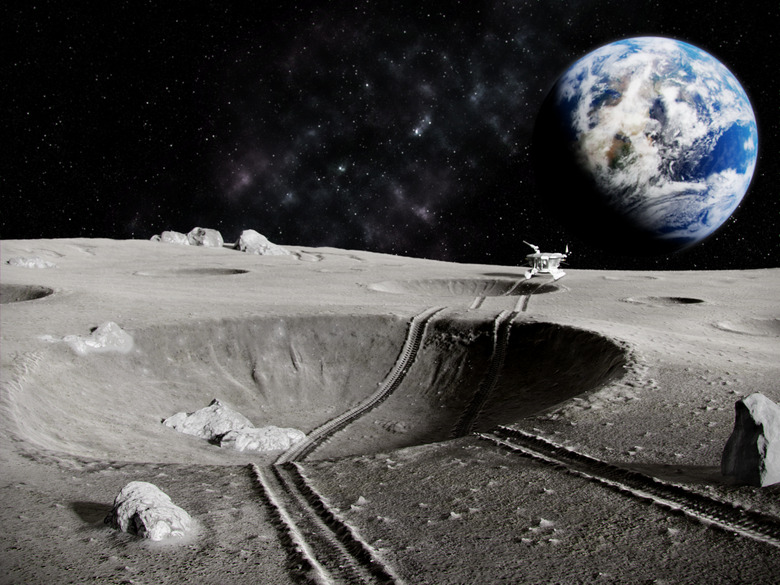Remembering Katherine Johnson And The Women Behind The Moon Landing
Before men walked on the moon, several women did the math that made it all possible. Katherine Johnson was one of those mathematicians, and she died at the age of 101 this week.
Toward the end of her life, she started to get the recognition she deserved for her important work at NASA. You may have seen her portrayed by Taraji P. Henson in the movie "Hidden Figures," or learned about her as one of the people to get a Presidential Medal of Freedom from President Barack Obama. Maybe you saw the standing ovation she received during the Oscars, when she was celebrated for her work during the awards ceremony in the year that Hidden Figures was nominated.
But earlier in her life, when she was doing the complex math that would safely send American astronauts into space, Johnson did not get nearly the recognition she deserved. She grew up during a time when black women faced even more discrimination than they do today.
Though some of the famous astronauts, particularly John Glenn, knew that Johnson and her colleagues were the masterminds behind their flights, those men were the ones who received international fame, recognition and more opportunities for wealth while she went almost totally unnoticed.
But Wait ... What Did Astronauts Need Mathematicians For?
But Wait ... What Did Astronauts Need Mathematicians For?
When you think about rockets blasting into space, you're probably thinking more about the powerful machines that can make it that far, or the space suits that astronauts wear to help them survive in zero gravity.
But before any machines or space suits get built, mathematicians had to figure out the trajectory of the rocket. And figuring out trajectories involves complex math. Before the moon landing, NASA had a pretty good idea of how to propel stuff into space. They just weren't sure how to make sure it came back down.
But not just up and down any which way! The mathematicians had to figure out the equations that would blast a rocket 238,900 miles away into the absolute vastness of space to land on a specific spot on the moon. Then, after some guys walk around the surface for a bit, they had to figure out a way for them to get back in that rocket and land it within just a 20-mile portion of the ocean. The whole thing made finding a needle in a haystack seem easy.
How Did They Do It?
How Did They Do It?
They went back in time. Well, kind of – in order to propel NASA's astronaut program into the future, they turned to math that was centuries old. Back in the 1700s, a Swiss mathematician named Leonhard Euler was hard at work developing some of the most important concepts and methods that exist in math even today.
He knew that although math is known for being exact and precise, that many problems require mathematicians to figure out equations for situations where there's not quite a solution (yet). After all, NASA hadn't put people into space yet, so while they had an idea of how to do it, they didn't quite know all the exact numbers they needed to take them there.
Johnson and her colleagues knew they needed to account for factors like the force of gravity pulling the spaceships back toward Earth, as well as how fast the spaceship would travel on its way back to our planet. And the stakes were too high to just hazard guesses and see how it went – even the tiniest miscalculation could mean death for the astronauts, as well as an end to the space program that was uniting a nation.
It was Johnson who had an aha! moment that took her to Euler. His method allowed her and her fellow female mathematicians to work as literal computers (as in, people who compute) to calculate the spaceship's trajectory in approximate terms rather than working toward a concrete solution where one slip-up would spell disaster.
Long story short: It worked. Neil Armstrong walked on the moon, the men made it back safely, and Katherine Johnson continued her prolific career with barely anyone knowing her name.
Math: It Might Actually Come in Handy
Math: It Might Actually Come in Handy
It's easy to see how Katherine Johnson used her incredible mathematical mind to help perform awe-inspiring things. It's less easy to see how the math you're doing in your class can lead to such results. After all, how is memorizing multiplication tables or wrapping your mind around algebra supposed to send more people to the moon?
But Johnson's reliance on a centuries-old method of math, as well as her dogged persistence in trying to crack the problem of sending people to space, demonstrates how a working knowledge of math can help your brain work in new and exciting ways.
Take Euler as an example. He lived in time when when almost no one had working toilets inside their homes. There's no way he could have believed that the equations he worked on would one day send humans to walk on the moon.
But he forged ahead anyway, understanding that his methods could one day be applied to problems way beyond his imagination. He, and then Johnson centuries later, embraced the way that learning about math expanded their brains, forced them to think about things in different ways, and helped them approach problems logically.
The end result? A solution to a problem that once seemed unsolvable.
Cite This Article
MLA
Dragani, Rachelle. "Remembering Katherine Johnson And The Women Behind The Moon Landing" sciencing.com, https://www.sciencing.com/who-is-katherine-johnson-13725116/. 27 February 2020.
APA
Dragani, Rachelle. (2020, February 27). Remembering Katherine Johnson And The Women Behind The Moon Landing. sciencing.com. Retrieved from https://www.sciencing.com/who-is-katherine-johnson-13725116/
Chicago
Dragani, Rachelle. Remembering Katherine Johnson And The Women Behind The Moon Landing last modified August 30, 2022. https://www.sciencing.com/who-is-katherine-johnson-13725116/
